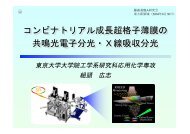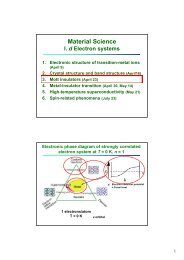Thesis High-Resolution Photoemission Study of Kondo Insulators ...
Thesis High-Resolution Photoemission Study of Kondo Insulators ...
Thesis High-Resolution Photoemission Study of Kondo Insulators ...
Create successful ePaper yourself
Turn your PDF publications into a flip-book with our unique Google optimized e-Paper software.
6.3. Results and Discussion 81<br />
6.3 Results and Discussion<br />
6.3.1 Substitution Dependence at 7 K<br />
First we focus on the photoemission spectra taken at 7 K, where the effect <strong>of</strong> the<br />
Lu substitution appears clearly. The upper panel <strong>of</strong> Fig. 6.3 shows He I photoemission<br />
spectra <strong>of</strong> Yb1−xLuxB12 (x = 0.25, 0.50, 0.75, and 1.00) and that <strong>of</strong> YbB12 [6.2] taken at<br />
7 K. All the spectra have been normalized to the integrated intensity below − 200 meV.<br />
In the lower panel <strong>of</strong> the figure, we have subtracted the spectrum <strong>of</strong> LuB12 from those<br />
<strong>of</strong> Yb1−xLuxB12 (x = 0.00, 0.25, 0.50, and 0.75). In going from LuB12 to YbB12, the<br />
intensity <strong>of</strong> the broad peak around − 80 meV develops whereas the intensity between<br />
EF and ∼−30 meV is reduced. The energy position <strong>of</strong> the broad peak is almost<br />
independent <strong>of</strong> the Lu content.<br />
In the band-structure calculation <strong>of</strong> YbB12 [6.8], the boron p partial DOS near<br />
the Yb 4f peak is modulated due to hybridization with the Yb 4f states as shown<br />
in Fig. 6.4: A sharp peak appears at ∼ 0.1 eV above the Yb 4f level and a broad<br />
shoulder appears at ∼ 0.4 eV below the f level. The broad peak around − 80 meV<br />
in the photoemission spectra would correspond mainly to the latter structure <strong>of</strong> the<br />
conduction band caused by the B p -Ybf hybridization. The reduction <strong>of</strong> the energy<br />
scale compared to the band-structure calculation would be due to electron correlation<br />
within the Yb 4f band. That is, the Yb 4f peak is located at ∼−25 meV in the<br />
photoemission spectra whereas the calculated Yb f DOS extends from ∼−0.1 eV to<br />
∼−0.4 eV (Chap. 3). Also, that the effective Yb f -Bp hybridization strength has<br />
been reduced by the electron correlation at the Yb site leads to another deviation from<br />
the band-structure calculation. On the other hand, no trace <strong>of</strong> the B p-derived sharp<br />
peak predicted by the band-structure calculation is observed in the difference spectra<br />
in the lower panel <strong>of</strong> Fig. 6.3. The B p-derived sharp peak might be largely located<br />
above EF .<br />
The spectra near EF is shown in the upper panel <strong>of</strong> Fig. 6.5 on an enlarged energy<br />
scale. In the lower panel we show the photoemission spectra <strong>of</strong> the polycrystals taken<br />
at ∼ 30 K with resolution <strong>of</strong> 21-25 meV, normalized to the integrated intensity between<br />
− 200 meV and − 260 meV as done for the spectra <strong>of</strong> the single crystals2 . Note<br />
that the spectra for the single crystals were taken at lower temperature and with higher<br />
2 In Chap. 4 we have normalized the He I spectra <strong>of</strong> Yb1−xLuxB12 to the intensity around ∼−100<br />
meV to discuss only the vicinity <strong>of</strong> EF .






